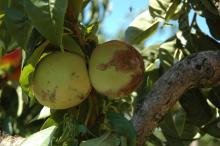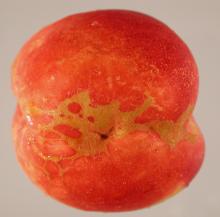See:
Prune and Plum (Prunus spp.) - Russeting
Apple (Malus spp.) - Fruit Russeting
Cause Many factors can cause surface scarring or russeting, including insect damage and mechanical rubbing of young fruit. Thrips nymphs hatch and feed in numbers on tiny fruit, often under the drying calyx or flower parts. Their feeding scars the surface of the fruit which may cause fruit deformity as the fruit enlarges. The most significant damage occurs during and shortly after pollination. Lygus and stink bugs also can damage fruit at this time. Damage is sporadic and occasional in the Willamette Valley of Oregon. It may be in only a portion or along the border of an orchard. Earwigs can also be a problem with nectarine scaring.
Applications of copper-based pesticides after shuck split was not associated with increased russeting for either peach or nectarine.
Symptoms Young fruit may be scarred, russeted, dimpled, distorted or pock marked.
Cultural control
- To prevent driving thrips into the trees, do not disc the cover crop when trees are in bloom.
- Control insects just after pollination. See the PNW Insect Management Handbook for details.
References Lalancette, N, and McFarland, K. A. 2007. Phytotoxicity of copper-based bactericides to peach and nectarine. Plant disease 91:1122-1130.
McLaren, G. F., and Fraser, J. A. 2000. Development of thresholds for insecticidal control of New Zealand flower thrips on nectarines in spring. New Zealand Plant Protection, 53:194-199.


